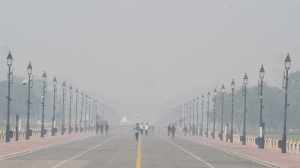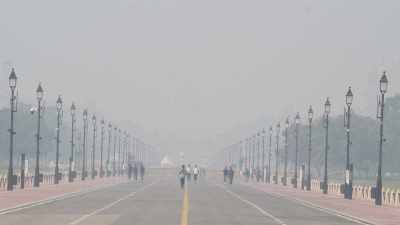Gusts of wind and trees start falling in Delhi. Why does this happen?
Issues ranging from root damage, poor or irregular pruning, widespread concretisation around trunks, termite attacks, unscientific cabling, and a lack of updated data on tree health have all added to the problem.
 This isn't even the first time that Delhi's neighbourhoods and busy roads witnessed trees falling at such a large scale. (Express Photo by Praveen Khanna)
This isn't even the first time that Delhi's neighbourhoods and busy roads witnessed trees falling at such a large scale. (Express Photo by Praveen Khanna)-A healthy peepal tree fell close to the President’s Estate in Lutyens’ Delhi.
-At the Army Depot, a giant neem tree fell and blocked the main entrance.
-Outside the AIIMS Trauma Centre, another large tree came down.
-In Sheikh Sarai, a tree fell on a car while its roots left another car suspended in the air.
-In Vasant Kunj fallen trees crushed parked cars. South Delhi’s Aurobindo Marg and Defence Colony were also not spared.
These trees were among 200 that came toppling down when an intense thunderstorm — strong winds reaching up to dangerous speeds of 80 kmph accompanied by 77 mm of rain — hit Delhi on Friday.
As the rain, the second-highest single-day May rainfall in Delhi since 1901, swept through the city, it also brought down large branches, damaged vehicles, power lines and public infrastructure, and led to the loss of four lives.
This isn’t even the first time that Delhi’s neighbourhoods and busy roads witnessed trees falling at such a large scale.
In May 2022, a ‘severe’ category storm claimed two lives and uprooted hundreds of trees across Delhi, including a total of 77 trees under the New Delhi Municipal Council (NDMC), while damaging over 50 branches.
Why does this happen?
Experts said the extreme weather does play a major role. But it isn’t the only cause.
Issues ranging from root damage, poor or irregular pruning, widespread concretisation around trunks, termite attacks, unscientific cabling, and a lack of updated data on tree health have all added to the problem.
For context, Delhi has 147 sq km of tree cover that falls outside forest areas. This is around 9.8% of Delhi’s geographical area as per the India State of Forest Report (IFRS) 2023.
Why isn’t anything being done to prevent this?
The answer to this lies in a complex web of laws and guidelines, and a 2023 Delhi High Court order.
Delhi has laws and administrative guidelines that outline how trees are to be maintained, pruned, and protected. It also includes who is responsible for assessing their health and ensuring they don’t pose risks during such weather events.
These rules are grounded in the Delhi Preservation of Trees Act (DPTA), 1994; its associated 2019 Guidelines for Pruning; and several binding orders from the Delhi High Court and National Green Tribunal (NGT) over the last decade.
Under the DPTA, 1994, any tree in the city — including on roadsides, parks, colonies, or government land — is protected if its trunk is at least 5 cm thick and 1 metre tall.
Day-to-day tree care on public land is under several civic agencies. Under the 2019 pruning guidelines, the Deputy Director (Horticulture) of each land-owning agency is held responsible for cutting or pruning trees on its property.
The Municipal Corporation of Delhi (MCD) (for most neighbourhoods) and NDMC (for Lutyens’ Delhi) each have horticulture wings that trim or plant street trees.
The Public Works Department looks after highway and main-road trees, and the Delhi Development Authority (DDA) handles trees in DDA parks and housing areas.
However, a Delhi High Court order in 2023 changed things. It prohibited any agency from pruning a tree without first consulting the Forest Department-appointed Tree Officers in respective forest divisions.
For routine pruning, like cutting small branches (less than 15.7 cm in girth), permission was not needed earlier — this clause was struck down by the High Court. Now, all significant pruning must follow the full legal process under the Trees Act — which means filing an application, an inspection by the Tree Officer, and written approval.
The department also has the power to direct land-owning agencies to take action like deconcretisation, transplantation, and also to impose fines in cases of neglect.
On whether regular pruning — heavy or light — is possible, officials cited a host of concerns, including shortage of staff, machinery and statutory hurdles that delay or discourage periodic pruning in key areas.
Explaining the conundrum, NDMC Director (Horticulture) Chellaiah Sellamuthu said, “Pruning practices are often discouraged due to strict regulations under the DPTA and frequent objections by tree activists.”
“There is no distinction between forest and non-forest trees in urban areas. The DPTA needs to treat them differently and allow horticultural practices that suit city conditions,” he added.
Other factors
According to Sellamuthu, the city’s trees are vulnerable to multiple stressors.
“In dry months, the shallow watering provided by tankers doesn’t reach the roots,” he said.
Giving an example, the senior official said the canopy of Philkan trees on Zakir Husain Marg is spread around from the trunk area and vertically as well. But the root penetration is not as much. “As a thumb rule, the canopy size and the root size should be in proportion, balancing each other to ensure tree stability and avoid risks,” he said.
He also pointed to a termites invasion, which hollow out a tree internally. That weakens the tree’s structure over time,” he said.
On Akbar Road, tamarind trees are on the brink to fall because the trunks have been hollowed out by termites.
One of the biggest threats is concretisation — pouring cement around a tree’s base, which chokes roots and cuts off aeration.
A notice was issued in 2019 by the Forest Department informing all departments and civic agencies that concretisation of trees damages them and is an offence under the DPTA, 1994. “The concrete surrounding the trees within one metre of the trees are removed forthwith and due precaution taken in future so that no concrete or construction or repairing work is done at least within one metre radius of the trunk of trees,” stated the circular.
In 2013, the NGT had ordered that at least a one-metre radius around every tree must be free of concrete. All agencies were told to remove tiles, walls, or any construction from around tree trunks.
Sellamuthu also pointed to cabling work as a common source of root damage. “Trenchless boring is done to lay internet and utility cables. But the one-metre limit for such work is impractical — tree roots spread much further, and any disruption affects the entire system,” he said.
Staff shortage is another problem. As per Section 9 of the Trees Act, every tree felling or pruning request must be followed by a site inspection by the Tree Officer, who is supposed to examine the tree’s health, structure, and need for action. But Delhi has only a handful of Tree Officers to cover the entire city.
The lack of data doesn’t help matters either. Every land-owning agency is supposed to keep a record of trees on their land, including girth, species, and health status.
However, Delhi lacks a city-wide, updated, public tree census. The Supreme Court, in a December 2024 order, allowed Dehradun-based Forest Research Institute (FRI) to collaborate with Geo-Spatial Delhi Limited (GSDL) for tree census activities. It apprised the top court of its budgetary needs to undertake such a census, as well as Delhi’s green cover expansion plan.
Previously, there have been efforts by various agencies to conduct a tree census in their jurisdictional areas. In 2020, the NDMC completed a tree census covering 1.8 lakh trees, including data on species, height, canopy area, girth size, tilt, and whether a tree was hollow. However, officials said this has not been published or digitised due to administrative reasons.
The MCD, too, last year, started the process to geo-tag trees, which has not been fully completed yet, as per officials. The corporation had identified 1,98,117 trees preliminarily in a first-of-a-kind tree census in 2024.







